-
EXECUTIVE SUMMARY
-
Market Overview
-
Key Findings
-
Market Segmentation
-
Competitive Landscape
-
Challenges and Opportunities
-
Future Outlook
-
MARKET INTRODUCTION
-
Definition
-
Scope of the study
- Research Objective
- Assumption
- Limitations
-
RESEARCH METHODOLOGY
-
Overview
-
Data Mining
-
Secondary Research
-
Primary Research
- Primary Interviews and Information Gathering Process
- Breakdown of Primary Respondents
-
Forecasting Model
-
Market Size Estimation
- Bottom-Up Approach
- Top-Down Approach
-
Data Triangulation
-
Validation
-
MARKET DYNAMICS
-
Overview
-
Drivers
-
Restraints
-
Opportunities
-
MARKET FACTOR ANALYSIS
-
Value chain Analysis
-
Porter's Five Forces Analysis
- Bargaining Power of Suppliers
- Bargaining Power of Buyers
- Threat of New Entrants
- Threat of Substitutes
- Intensity of Rivalry
-
COVID-19 Impact Analysis
- Market Impact Analysis
- Regional Impact
- Opportunity and Threat Analysis
-
VEHICLE ANTI-THEFT MARKET, BY TECHNOLOGY (USD BILLION)
-
Remote Keyless Entry
-
Steering Wheel Lock
-
GPS Tracking Systems
-
Immobilizers
-
Alarm Systems
-
VEHICLE ANTI-THEFT MARKET, BY TYPE (USD BILLION)
-
Active Anti-Theft Systems
-
Passive Anti-Theft Systems
-
Smart Anti-Theft Systems
-
VEHICLE ANTI-THEFT MARKET, BY END USE (USD BILLION)
-
Passenger Vehicles
-
Commercial Vehicles
-
Motorcycles
-
Heavy Vehicles
-
VEHICLE ANTI-THEFT MARKET, BY SALES CHANNEL (USD BILLION)
-
Online
-
Offline
-
Dealerships
-
VEHICLE ANTI-THEFT MARKET, BY REGIONAL (USD BILLION)
-
North America
- US
- Canada
-
Europe
- Germany
- UK
- France
- Russia
- Italy
- Spain
- Rest of Europe
-
APAC
- China
- India
- Japan
- South Korea
- Malaysia
- Thailand
- Indonesia
- Rest of APAC
-
South America
- Brazil
- Mexico
- Argentina
- Rest of South America
-
MEA
- GCC Countries
- South Africa
- Rest of MEA
-
COMPETITIVE LANDSCAPE
-
Overview
-
Competitive Analysis
-
Market share Analysis
-
Major Growth Strategy in the Vehicle Anti-Theft Market
-
Competitive Benchmarking
-
Leading Players in Terms of Number of Developments in the Vehicle Anti-Theft Market
-
Key developments and growth strategies
- New Product Launch/Service Deployment
- Merger & Acquisitions
- Joint Ventures
-
Major Players Financial Matrix
- Sales and Operating Income
- Major Players R&D Expenditure. 2023
-
COMPANY PROFILES
-
Cobra
- Financial Overview
- Products Offered
- Key Developments
- SWOT Analysis
- Key Strategies
-
Tracki
- Financial Overview
- Products Offered
- Key Developments
- SWOT Analysis
- Key Strategies
-
CarLock
- Financial Overview
- Products Offered
- Key Developments
- SWOT Analysis
- Key Strategies
-
Viper
- Financial Overview
- Products Offered
- Key Developments
- SWOT Analysis
- Key Strategies
-
LoJack
- Financial Overview
- Products Offered
- Key Developments
- SWOT Analysis
- Key Strategies
-
Siren GPS
- Financial Overview
- Products Offered
- Key Developments
- SWOT Analysis
- Key Strategies
-
Compustar
- Financial Overview
- Products Offered
- Key Developments
- SWOT Analysis
- Key Strategies
-
Fortin
- Financial Overview
- Products Offered
- Key Developments
- SWOT Analysis
- Key Strategies
-
Toyota
- Financial Overview
- Products Offered
- Key Developments
- SWOT Analysis
- Key Strategies
-
Meta
- Financial Overview
- Products Offered
- Key Developments
- SWOT Analysis
- Key Strategies
-
Bose
- Financial Overview
- Products Offered
- Key Developments
- SWOT Analysis
- Key Strategies
-
Pitbull
- Financial Overview
- Products Offered
- Key Developments
- SWOT Analysis
- Key Strategies
-
Honda
- Financial Overview
- Products Offered
- Key Developments
- SWOT Analysis
- Key Strategies
-
TAMOEM
- Financial Overview
- Products Offered
- Key Developments
- SWOT Analysis
- Key Strategies
-
ADP
- Financial Overview
- Products Offered
- Key Developments
- SWOT Analysis
- Key Strategies
-
APPENDIX
-
References
-
Related Reports
-
LIST OF TABLES
-
LIST OF ASSUMPTIONS
-
NORTH AMERICA VEHICLE ANTI-THEFT MARKET SIZE ESTIMATES & FORECAST, BY TECHNOLOGY, 2019-2035 (USD BILLIONS)
-
NORTH AMERICA VEHICLE ANTI-THEFT MARKET SIZE ESTIMATES & FORECAST, BY TYPE, 2019-2035 (USD BILLIONS)
-
NORTH AMERICA VEHICLE ANTI-THEFT MARKET SIZE ESTIMATES & FORECAST, BY END USE, 2019-2035 (USD BILLIONS)
-
NORTH AMERICA VEHICLE ANTI-THEFT MARKET SIZE ESTIMATES & FORECAST, BY SALES CHANNEL, 2019-2035 (USD BILLIONS)
-
NORTH AMERICA VEHICLE ANTI-THEFT MARKET SIZE ESTIMATES & FORECAST, BY REGIONAL, 2019-2035 (USD BILLIONS)
-
US VEHICLE ANTI-THEFT MARKET SIZE ESTIMATES & FORECAST, BY TECHNOLOGY, 2019-2035 (USD BILLIONS)
-
US VEHICLE ANTI-THEFT MARKET SIZE ESTIMATES & FORECAST, BY TYPE, 2019-2035 (USD BILLIONS)
-
US VEHICLE ANTI-THEFT MARKET SIZE ESTIMATES & FORECAST, BY END USE, 2019-2035 (USD BILLIONS)
-
US VEHICLE ANTI-THEFT MARKET SIZE ESTIMATES & FORECAST, BY SALES CHANNEL, 2019-2035 (USD BILLIONS)
-
US VEHICLE ANTI-THEFT MARKET SIZE ESTIMATES & FORECAST, BY REGIONAL, 2019-2035 (USD BILLIONS)
-
CANADA VEHICLE ANTI-THEFT MARKET SIZE ESTIMATES & FORECAST, BY TECHNOLOGY, 2019-2035 (USD BILLIONS)
-
CANADA VEHICLE ANTI-THEFT MARKET SIZE ESTIMATES & FORECAST, BY TYPE, 2019-2035 (USD BILLIONS)
-
CANADA VEHICLE ANTI-THEFT MARKET SIZE ESTIMATES & FORECAST, BY END USE, 2019-2035 (USD BILLIONS)
-
CANADA VEHICLE ANTI-THEFT MARKET SIZE ESTIMATES & FORECAST, BY SALES CHANNEL, 2019-2035 (USD BILLIONS)
-
CANADA VEHICLE ANTI-THEFT MARKET SIZE ESTIMATES & FORECAST, BY REGIONAL, 2019-2035 (USD BILLIONS)
-
EUROPE VEHICLE ANTI-THEFT MARKET SIZE ESTIMATES & FORECAST, BY TECHNOLOGY, 2019-2035 (USD BILLIONS)
-
EUROPE VEHICLE ANTI-THEFT MARKET SIZE ESTIMATES & FORECAST, BY TYPE, 2019-2035 (USD BILLIONS)
-
EUROPE VEHICLE ANTI-THEFT MARKET SIZE ESTIMATES & FORECAST, BY END USE, 2019-2035 (USD BILLIONS)
-
EUROPE VEHICLE ANTI-THEFT MARKET SIZE ESTIMATES & FORECAST, BY SALES CHANNEL, 2019-2035 (USD BILLIONS)
-
EUROPE VEHICLE ANTI-THEFT MARKET SIZE ESTIMATES & FORECAST, BY REGIONAL, 2019-2035 (USD BILLIONS)
-
GERMANY VEHICLE ANTI-THEFT MARKET SIZE ESTIMATES & FORECAST, BY TECHNOLOGY, 2019-2035 (USD BILLIONS)
-
GERMANY VEHICLE ANTI-THEFT MARKET SIZE ESTIMATES & FORECAST, BY TYPE, 2019-2035 (USD BILLIONS)
-
GERMANY VEHICLE ANTI-THEFT MARKET SIZE ESTIMATES & FORECAST, BY END USE, 2019-2035 (USD BILLIONS)
-
GERMANY VEHICLE ANTI-THEFT MARKET SIZE ESTIMATES & FORECAST, BY SALES CHANNEL, 2019-2035 (USD BILLIONS)
-
GERMANY VEHICLE ANTI-THEFT MARKET SIZE ESTIMATES & FORECAST, BY REGIONAL, 2019-2035 (USD BILLIONS)
-
UK VEHICLE ANTI-THEFT MARKET SIZE ESTIMATES & FORECAST, BY TECHNOLOGY, 2019-2035 (USD BILLIONS)
-
UK VEHICLE ANTI-THEFT MARKET SIZE ESTIMATES & FORECAST, BY TYPE, 2019-2035 (USD BILLIONS)
-
UK VEHICLE ANTI-THEFT MARKET SIZE ESTIMATES & FORECAST, BY END USE, 2019-2035 (USD BILLIONS)
-
UK VEHICLE ANTI-THEFT MARKET SIZE ESTIMATES & FORECAST, BY SALES CHANNEL, 2019-2035 (USD BILLIONS)
-
UK VEHICLE ANTI-THEFT MARKET SIZE ESTIMATES & FORECAST, BY REGIONAL, 2019-2035 (USD BILLIONS)
-
FRANCE VEHICLE ANTI-THEFT MARKET SIZE ESTIMATES & FORECAST, BY TECHNOLOGY, 2019-2035 (USD BILLIONS)
-
FRANCE VEHICLE ANTI-THEFT MARKET SIZE ESTIMATES & FORECAST, BY TYPE, 2019-2035 (USD BILLIONS)
-
FRANCE VEHICLE ANTI-THEFT MARKET SIZE ESTIMATES & FORECAST, BY END USE, 2019-2035 (USD BILLIONS)
-
FRANCE VEHICLE ANTI-THEFT MARKET SIZE ESTIMATES & FORECAST, BY SALES CHANNEL, 2019-2035 (USD BILLIONS)
-
FRANCE VEHICLE ANTI-THEFT MARKET SIZE ESTIMATES & FORECAST, BY REGIONAL, 2019-2035 (USD BILLIONS)
-
RUSSIA VEHICLE ANTI-THEFT MARKET SIZE ESTIMATES & FORECAST, BY TECHNOLOGY, 2019-2035 (USD BILLIONS)
-
RUSSIA VEHICLE ANTI-THEFT MARKET SIZE ESTIMATES & FORECAST, BY TYPE, 2019-2035 (USD BILLIONS)
-
RUSSIA VEHICLE ANTI-THEFT MARKET SIZE ESTIMATES & FORECAST, BY END USE, 2019-2035 (USD BILLIONS)
-
RUSSIA VEHICLE ANTI-THEFT MARKET SIZE ESTIMATES & FORECAST, BY SALES CHANNEL, 2019-2035 (USD BILLIONS)
-
RUSSIA VEHICLE ANTI-THEFT MARKET SIZE ESTIMATES & FORECAST, BY REGIONAL, 2019-2035 (USD BILLIONS)
-
ITALY VEHICLE ANTI-THEFT MARKET SIZE ESTIMATES & FORECAST, BY TECHNOLOGY, 2019-2035 (USD BILLIONS)
-
ITALY VEHICLE ANTI-THEFT MARKET SIZE ESTIMATES & FORECAST, BY TYPE, 2019-2035 (USD BILLIONS)
-
ITALY VEHICLE ANTI-THEFT MARKET SIZE ESTIMATES & FORECAST, BY END USE, 2019-2035 (USD BILLIONS)
-
ITALY VEHICLE ANTI-THEFT MARKET SIZE ESTIMATES & FORECAST, BY SALES CHANNEL, 2019-2035 (USD BILLIONS)
-
ITALY VEHICLE ANTI-THEFT MARKET SIZE ESTIMATES & FORECAST, BY REGIONAL, 2019-2035 (USD BILLIONS)
-
SPAIN VEHICLE ANTI-THEFT MARKET SIZE ESTIMATES & FORECAST, BY TECHNOLOGY, 2019-2035 (USD BILLIONS)
-
SPAIN VEHICLE ANTI-THEFT MARKET SIZE ESTIMATES & FORECAST, BY TYPE, 2019-2035 (USD BILLIONS)
-
SPAIN VEHICLE ANTI-THEFT MARKET SIZE ESTIMATES & FORECAST, BY END USE, 2019-2035 (USD BILLIONS)
-
SPAIN VEHICLE ANTI-THEFT MARKET SIZE ESTIMATES & FORECAST, BY SALES CHANNEL, 2019-2035 (USD BILLIONS)
-
SPAIN VEHICLE ANTI-THEFT MARKET SIZE ESTIMATES & FORECAST, BY REGIONAL, 2019-2035 (USD BILLIONS)
-
REST OF EUROPE VEHICLE ANTI-THEFT MARKET SIZE ESTIMATES & FORECAST, BY TECHNOLOGY, 2019-2035 (USD BILLIONS)
-
REST OF EUROPE VEHICLE ANTI-THEFT MARKET SIZE ESTIMATES & FORECAST, BY TYPE, 2019-2035 (USD BILLIONS)
-
REST OF EUROPE VEHICLE ANTI-THEFT MARKET SIZE ESTIMATES & FORECAST, BY END USE, 2019-2035 (USD BILLIONS)
-
REST OF EUROPE VEHICLE ANTI-THEFT MARKET SIZE ESTIMATES & FORECAST, BY SALES CHANNEL, 2019-2035 (USD BILLIONS)
-
REST OF EUROPE VEHICLE ANTI-THEFT MARKET SIZE ESTIMATES & FORECAST, BY REGIONAL, 2019-2035 (USD BILLIONS)
-
APAC VEHICLE ANTI-THEFT MARKET SIZE ESTIMATES & FORECAST, BY TECHNOLOGY, 2019-2035 (USD BILLIONS)
-
APAC VEHICLE ANTI-THEFT MARKET SIZE ESTIMATES & FORECAST, BY TYPE, 2019-2035 (USD BILLIONS)
-
APAC VEHICLE ANTI-THEFT MARKET SIZE ESTIMATES & FORECAST, BY END USE, 2019-2035 (USD BILLIONS)
-
APAC VEHICLE ANTI-THEFT MARKET SIZE ESTIMATES & FORECAST, BY SALES CHANNEL, 2019-2035 (USD BILLIONS)
-
APAC VEHICLE ANTI-THEFT MARKET SIZE ESTIMATES & FORECAST, BY REGIONAL, 2019-2035 (USD BILLIONS)
-
CHINA VEHICLE ANTI-THEFT MARKET SIZE ESTIMATES & FORECAST, BY TECHNOLOGY, 2019-2035 (USD BILLIONS)
-
CHINA VEHICLE ANTI-THEFT MARKET SIZE ESTIMATES & FORECAST, BY TYPE, 2019-2035 (USD BILLIONS)
-
CHINA VEHICLE ANTI-THEFT MARKET SIZE ESTIMATES & FORECAST, BY END USE, 2019-2035 (USD BILLIONS)
-
CHINA VEHICLE ANTI-THEFT MARKET SIZE ESTIMATES & FORECAST, BY SALES CHANNEL, 2019-2035 (USD BILLIONS)
-
CHINA VEHICLE ANTI-THEFT MARKET SIZE ESTIMATES & FORECAST, BY REGIONAL, 2019-2035 (USD BILLIONS)
-
INDIA VEHICLE ANTI-THEFT MARKET SIZE ESTIMATES & FORECAST, BY TECHNOLOGY, 2019-2035 (USD BILLIONS)
-
INDIA VEHICLE ANTI-THEFT MARKET SIZE ESTIMATES & FORECAST, BY TYPE, 2019-2035 (USD BILLIONS)
-
INDIA VEHICLE ANTI-THEFT MARKET SIZE ESTIMATES & FORECAST, BY END USE, 2019-2035 (USD BILLIONS)
-
INDIA VEHICLE ANTI-THEFT MARKET SIZE ESTIMATES & FORECAST, BY SALES CHANNEL, 2019-2035 (USD BILLIONS)
-
INDIA VEHICLE ANTI-THEFT MARKET SIZE ESTIMATES & FORECAST, BY REGIONAL, 2019-2035 (USD BILLIONS)
-
JAPAN VEHICLE ANTI-THEFT MARKET SIZE ESTIMATES & FORECAST, BY TECHNOLOGY, 2019-2035 (USD BILLIONS)
-
JAPAN VEHICLE ANTI-THEFT MARKET SIZE ESTIMATES & FORECAST, BY TYPE, 2019-2035 (USD BILLIONS)
-
JAPAN VEHICLE ANTI-THEFT MARKET SIZE ESTIMATES & FORECAST, BY END USE, 2019-2035 (USD BILLIONS)
-
JAPAN VEHICLE ANTI-THEFT MARKET SIZE ESTIMATES & FORECAST, BY SALES CHANNEL, 2019-2035 (USD BILLIONS)
-
JAPAN VEHICLE ANTI-THEFT MARKET SIZE ESTIMATES & FORECAST, BY REGIONAL, 2019-2035 (USD BILLIONS)
-
SOUTH KOREA VEHICLE ANTI-THEFT MARKET SIZE ESTIMATES & FORECAST, BY TECHNOLOGY, 2019-2035 (USD BILLIONS)
-
SOUTH KOREA VEHICLE ANTI-THEFT MARKET SIZE ESTIMATES & FORECAST, BY TYPE, 2019-2035 (USD BILLIONS)
-
SOUTH KOREA VEHICLE ANTI-THEFT MARKET SIZE ESTIMATES & FORECAST, BY END USE, 2019-2035 (USD BILLIONS)
-
SOUTH KOREA VEHICLE ANTI-THEFT MARKET SIZE ESTIMATES & FORECAST, BY SALES CHANNEL, 2019-2035 (USD BILLIONS)
-
SOUTH KOREA VEHICLE ANTI-THEFT MARKET SIZE ESTIMATES & FORECAST, BY REGIONAL, 2019-2035 (USD BILLIONS)
-
MALAYSIA VEHICLE ANTI-THEFT MARKET SIZE ESTIMATES & FORECAST, BY TECHNOLOGY, 2019-2035 (USD BILLIONS)
-
MALAYSIA VEHICLE ANTI-THEFT MARKET SIZE ESTIMATES & FORECAST, BY TYPE, 2019-2035 (USD BILLIONS)
-
MALAYSIA VEHICLE ANTI-THEFT MARKET SIZE ESTIMATES & FORECAST, BY END USE, 2019-2035 (USD BILLIONS)
-
MALAYSIA VEHICLE ANTI-THEFT MARKET SIZE ESTIMATES & FORECAST, BY SALES CHANNEL, 2019-2035 (USD BILLIONS)
-
MALAYSIA VEHICLE ANTI-THEFT MARKET SIZE ESTIMATES & FORECAST, BY REGIONAL, 2019-2035 (USD BILLIONS)
-
THAILAND VEHICLE ANTI-THEFT MARKET SIZE ESTIMATES & FORECAST, BY TECHNOLOGY, 2019-2035 (USD BILLIONS)
-
THAILAND VEHICLE ANTI-THEFT MARKET SIZE ESTIMATES & FORECAST, BY TYPE, 2019-2035 (USD BILLIONS)
-
THAILAND VEHICLE ANTI-THEFT MARKET SIZE ESTIMATES & FORECAST, BY END USE, 2019-2035 (USD BILLIONS)
-
THAILAND VEHICLE ANTI-THEFT MARKET SIZE ESTIMATES & FORECAST, BY SALES CHANNEL, 2019-2035 (USD BILLIONS)
-
THAILAND VEHICLE ANTI-THEFT MARKET SIZE ESTIMATES & FORECAST, BY REGIONAL, 2019-2035 (USD BILLIONS)
-
INDONESIA VEHICLE ANTI-THEFT MARKET SIZE ESTIMATES & FORECAST, BY TECHNOLOGY, 2019-2035 (USD BILLIONS)
-
INDONESIA VEHICLE ANTI-THEFT MARKET SIZE ESTIMATES & FORECAST, BY TYPE, 2019-2035 (USD BILLIONS)
-
INDONESIA VEHICLE ANTI-THEFT MARKET SIZE ESTIMATES & FORECAST, BY END USE, 2019-2035 (USD BILLIONS)
-
INDONESIA VEHICLE ANTI-THEFT MARKET SIZE ESTIMATES & FORECAST, BY SALES CHANNEL, 2019-2035 (USD BILLIONS)
-
INDONESIA VEHICLE ANTI-THEFT MARKET SIZE ESTIMATES & FORECAST, BY REGIONAL, 2019-2035 (USD BILLIONS)
-
REST OF APAC VEHICLE ANTI-THEFT MARKET SIZE ESTIMATES & FORECAST, BY TECHNOLOGY, 2019-2035 (USD BILLIONS)
-
REST OF APAC VEHICLE ANTI-THEFT MARKET SIZE ESTIMATES & FORECAST, BY TYPE, 2019-2035 (USD BILLIONS)
-
REST OF APAC VEHICLE ANTI-THEFT MARKET SIZE ESTIMATES & FORECAST, BY END USE, 2019-2035 (USD BILLIONS)
-
REST OF APAC VEHICLE ANTI-THEFT MARKET SIZE ESTIMATES & FORECAST, BY SALES CHANNEL, 2019-2035 (USD BILLIONS)
-
REST OF APAC VEHICLE ANTI-THEFT MARKET SIZE ESTIMATES & FORECAST, BY REGIONAL, 2019-2035 (USD BILLIONS)
-
SOUTH AMERICA VEHICLE ANTI-THEFT MARKET SIZE ESTIMATES & FORECAST, BY TECHNOLOGY, 2019-2035 (USD BILLIONS)
-
SOUTH AMERICA VEHICLE ANTI-THEFT MARKET SIZE ESTIMATES & FORECAST, BY TYPE, 2019-2035 (USD BILLIONS)
-
SOUTH AMERICA VEHICLE ANTI-THEFT MARKET SIZE ESTIMATES & FORECAST, BY END USE, 2019-2035 (USD BILLIONS)
-
SOUTH AMERICA VEHICLE ANTI-THEFT MARKET SIZE ESTIMATES & FORECAST, BY SALES CHANNEL, 2019-2035 (USD BILLIONS)
-
SOUTH AMERICA VEHICLE ANTI-THEFT MARKET SIZE ESTIMATES & FORECAST, BY REGIONAL, 2019-2035 (USD BILLIONS)
-
BRAZIL VEHICLE ANTI-THEFT MARKET SIZE ESTIMATES & FORECAST, BY TECHNOLOGY, 2019-2035 (USD BILLIONS)
-
BRAZIL VEHICLE ANTI-THEFT MARKET SIZE ESTIMATES & FORECAST, BY TYPE, 2019-2035 (USD BILLIONS)
-
BRAZIL VEHICLE ANTI-THEFT MARKET SIZE ESTIMATES & FORECAST, BY END USE, 2019-2035 (USD BILLIONS)
-
BRAZIL VEHICLE ANTI-THEFT MARKET SIZE ESTIMATES & FORECAST, BY SALES CHANNEL, 2019-2035 (USD BILLIONS)
-
BRAZIL VEHICLE ANTI-THEFT MARKET SIZE ESTIMATES & FORECAST, BY REGIONAL, 2019-2035 (USD BILLIONS)
-
MEXICO VEHICLE ANTI-THEFT MARKET SIZE ESTIMATES & FORECAST, BY TECHNOLOGY, 2019-2035 (USD BILLIONS)
-
MEXICO VEHICLE ANTI-THEFT MARKET SIZE ESTIMATES & FORECAST, BY TYPE, 2019-2035 (USD BILLIONS)
-
MEXICO VEHICLE ANTI-THEFT MARKET SIZE ESTIMATES & FORECAST, BY END USE, 2019-2035 (USD BILLIONS)
-
MEXICO VEHICLE ANTI-THEFT MARKET SIZE ESTIMATES & FORECAST, BY SALES CHANNEL, 2019-2035 (USD BILLIONS)
-
MEXICO VEHICLE ANTI-THEFT MARKET SIZE ESTIMATES & FORECAST, BY REGIONAL, 2019-2035 (USD BILLIONS)
-
ARGENTINA VEHICLE ANTI-THEFT MARKET SIZE ESTIMATES & FORECAST, BY TECHNOLOGY, 2019-2035 (USD BILLIONS)
-
ARGENTINA VEHICLE ANTI-THEFT MARKET SIZE ESTIMATES & FORECAST, BY TYPE, 2019-2035 (USD BILLIONS)
-
ARGENTINA VEHICLE ANTI-THEFT MARKET SIZE ESTIMATES & FORECAST, BY END USE, 2019-2035 (USD BILLIONS)
-
ARGENTINA VEHICLE ANTI-THEFT MARKET SIZE ESTIMATES & FORECAST, BY SALES CHANNEL, 2019-2035 (USD BILLIONS)
-
ARGENTINA VEHICLE ANTI-THEFT MARKET SIZE ESTIMATES & FORECAST, BY REGIONAL, 2019-2035 (USD BILLIONS)
-
REST OF SOUTH AMERICA VEHICLE ANTI-THEFT MARKET SIZE ESTIMATES & FORECAST, BY TECHNOLOGY, 2019-2035 (USD BILLIONS)
-
REST OF SOUTH AMERICA VEHICLE ANTI-THEFT MARKET SIZE ESTIMATES & FORECAST, BY TYPE, 2019-2035 (USD BILLIONS)
-
REST OF SOUTH AMERICA VEHICLE ANTI-THEFT MARKET SIZE ESTIMATES & FORECAST, BY END USE, 2019-2035 (USD BILLIONS)
-
REST OF SOUTH AMERICA VEHICLE ANTI-THEFT MARKET SIZE ESTIMATES & FORECAST, BY SALES CHANNEL, 2019-2035 (USD BILLIONS)
-
REST OF SOUTH AMERICA VEHICLE ANTI-THEFT MARKET SIZE ESTIMATES & FORECAST, BY REGIONAL, 2019-2035 (USD BILLIONS)
-
MEA VEHICLE ANTI-THEFT MARKET SIZE ESTIMATES & FORECAST, BY TECHNOLOGY, 2019-2035 (USD BILLIONS)
-
MEA VEHICLE ANTI-THEFT MARKET SIZE ESTIMATES & FORECAST, BY TYPE, 2019-2035 (USD BILLIONS)
-
MEA VEHICLE ANTI-THEFT MARKET SIZE ESTIMATES & FORECAST, BY END USE, 2019-2035 (USD BILLIONS)
-
MEA VEHICLE ANTI-THEFT MARKET SIZE ESTIMATES & FORECAST, BY SALES CHANNEL, 2019-2035 (USD BILLIONS)
-
MEA VEHICLE ANTI-THEFT MARKET SIZE ESTIMATES & FORECAST, BY REGIONAL, 2019-2035 (USD BILLIONS)
-
GCC COUNTRIES VEHICLE ANTI-THEFT MARKET SIZE ESTIMATES & FORECAST, BY TECHNOLOGY, 2019-2035 (USD BILLIONS)
-
GCC COUNTRIES VEHICLE ANTI-THEFT MARKET SIZE ESTIMATES & FORECAST, BY TYPE, 2019-2035 (USD BILLIONS)
-
GCC COUNTRIES VEHICLE ANTI-THEFT MARKET SIZE ESTIMATES & FORECAST, BY END USE, 2019-2035 (USD BILLIONS)
-
GCC COUNTRIES VEHICLE ANTI-THEFT MARKET SIZE ESTIMATES & FORECAST, BY SALES CHANNEL, 2019-2035 (USD BILLIONS)
-
GCC COUNTRIES VEHICLE ANTI-THEFT MARKET SIZE ESTIMATES & FORECAST, BY REGIONAL, 2019-2035 (USD BILLIONS)
-
SOUTH AFRICA VEHICLE ANTI-THEFT MARKET SIZE ESTIMATES & FORECAST, BY TECHNOLOGY, 2019-2035 (USD BILLIONS)
-
SOUTH AFRICA VEHICLE ANTI-THEFT MARKET SIZE ESTIMATES & FORECAST, BY TYPE, 2019-2035 (USD BILLIONS)
-
SOUTH AFRICA VEHICLE ANTI-THEFT MARKET SIZE ESTIMATES & FORECAST, BY END USE, 2019-2035 (USD BILLIONS)
-
SOUTH AFRICA VEHICLE ANTI-THEFT MARKET SIZE ESTIMATES & FORECAST, BY SALES CHANNEL, 2019-2035 (USD BILLIONS)
-
SOUTH AFRICA VEHICLE ANTI-THEFT MARKET SIZE ESTIMATES & FORECAST, BY REGIONAL, 2019-2035 (USD BILLIONS)
-
REST OF MEA VEHICLE ANTI-THEFT MARKET SIZE ESTIMATES & FORECAST, BY TECHNOLOGY, 2019-2035 (USD BILLIONS)
-
REST OF MEA VEHICLE ANTI-THEFT MARKET SIZE ESTIMATES & FORECAST, BY TYPE, 2019-2035 (USD BILLIONS)
-
REST OF MEA VEHICLE ANTI-THEFT MARKET SIZE ESTIMATES & FORECAST, BY END USE, 2019-2035 (USD BILLIONS)
-
REST OF MEA VEHICLE ANTI-THEFT MARKET SIZE ESTIMATES & FORECAST, BY SALES CHANNEL, 2019-2035 (USD BILLIONS)
-
REST OF MEA VEHICLE ANTI-THEFT MARKET SIZE ESTIMATES & FORECAST, BY REGIONAL, 2019-2035 (USD BILLIONS)
-
PRODUCT LAUNCH/PRODUCT DEVELOPMENT/APPROVAL
-
ACQUISITION/PARTNERSHIP
-
LIST OF FIGURES
-
MARKET SYNOPSIS
-
NORTH AMERICA VEHICLE ANTI-THEFT MARKET ANALYSIS
-
US VEHICLE ANTI-THEFT MARKET ANALYSIS BY TECHNOLOGY
-
US VEHICLE ANTI-THEFT MARKET ANALYSIS BY TYPE
-
US VEHICLE ANTI-THEFT MARKET ANALYSIS BY END USE
-
US VEHICLE ANTI-THEFT MARKET ANALYSIS BY SALES CHANNEL
-
US VEHICLE ANTI-THEFT MARKET ANALYSIS BY REGIONAL
-
CANADA VEHICLE ANTI-THEFT MARKET ANALYSIS BY TECHNOLOGY
-
CANADA VEHICLE ANTI-THEFT MARKET ANALYSIS BY TYPE
-
CANADA VEHICLE ANTI-THEFT MARKET ANALYSIS BY END USE
-
CANADA VEHICLE ANTI-THEFT MARKET ANALYSIS BY SALES CHANNEL
-
CANADA VEHICLE ANTI-THEFT MARKET ANALYSIS BY REGIONAL
-
EUROPE VEHICLE ANTI-THEFT MARKET ANALYSIS
-
GERMANY VEHICLE ANTI-THEFT MARKET ANALYSIS BY TECHNOLOGY
-
GERMANY VEHICLE ANTI-THEFT MARKET ANALYSIS BY TYPE
-
GERMANY VEHICLE ANTI-THEFT MARKET ANALYSIS BY END USE
-
GERMANY VEHICLE ANTI-THEFT MARKET ANALYSIS BY SALES CHANNEL
-
GERMANY VEHICLE ANTI-THEFT MARKET ANALYSIS BY REGIONAL
-
UK VEHICLE ANTI-THEFT MARKET ANALYSIS BY TECHNOLOGY
-
UK VEHICLE ANTI-THEFT MARKET ANALYSIS BY TYPE
-
UK VEHICLE ANTI-THEFT MARKET ANALYSIS BY END USE
-
UK VEHICLE ANTI-THEFT MARKET ANALYSIS BY SALES CHANNEL
-
UK VEHICLE ANTI-THEFT MARKET ANALYSIS BY REGIONAL
-
FRANCE VEHICLE ANTI-THEFT MARKET ANALYSIS BY TECHNOLOGY
-
FRANCE VEHICLE ANTI-THEFT MARKET ANALYSIS BY TYPE
-
FRANCE VEHICLE ANTI-THEFT MARKET ANALYSIS BY END USE
-
FRANCE VEHICLE ANTI-THEFT MARKET ANALYSIS BY SALES CHANNEL
-
FRANCE VEHICLE ANTI-THEFT MARKET ANALYSIS BY REGIONAL
-
RUSSIA VEHICLE ANTI-THEFT MARKET ANALYSIS BY TECHNOLOGY
-
RUSSIA VEHICLE ANTI-THEFT MARKET ANALYSIS BY TYPE
-
RUSSIA VEHICLE ANTI-THEFT MARKET ANALYSIS BY END USE
-
RUSSIA VEHICLE ANTI-THEFT MARKET ANALYSIS BY SALES CHANNEL
-
RUSSIA VEHICLE ANTI-THEFT MARKET ANALYSIS BY REGIONAL
-
ITALY VEHICLE ANTI-THEFT MARKET ANALYSIS BY TECHNOLOGY
-
ITALY VEHICLE ANTI-THEFT MARKET ANALYSIS BY TYPE
-
ITALY VEHICLE ANTI-THEFT MARKET ANALYSIS BY END USE
-
ITALY VEHICLE ANTI-THEFT MARKET ANALYSIS BY SALES CHANNEL
-
ITALY VEHICLE ANTI-THEFT MARKET ANALYSIS BY REGIONAL
-
SPAIN VEHICLE ANTI-THEFT MARKET ANALYSIS BY TECHNOLOGY
-
SPAIN VEHICLE ANTI-THEFT MARKET ANALYSIS BY TYPE
-
SPAIN VEHICLE ANTI-THEFT MARKET ANALYSIS BY END USE
-
SPAIN VEHICLE ANTI-THEFT MARKET ANALYSIS BY SALES CHANNEL
-
SPAIN VEHICLE ANTI-THEFT MARKET ANALYSIS BY REGIONAL
-
REST OF EUROPE VEHICLE ANTI-THEFT MARKET ANALYSIS BY TECHNOLOGY
-
REST OF EUROPE VEHICLE ANTI-THEFT MARKET ANALYSIS BY TYPE
-
REST OF EUROPE VEHICLE ANTI-THEFT MARKET ANALYSIS BY END USE
-
REST OF EUROPE VEHICLE ANTI-THEFT MARKET ANALYSIS BY SALES CHANNEL
-
REST OF EUROPE VEHICLE ANTI-THEFT MARKET ANALYSIS BY REGIONAL
-
APAC VEHICLE ANTI-THEFT MARKET ANALYSIS
-
CHINA VEHICLE ANTI-THEFT MARKET ANALYSIS BY TECHNOLOGY
-
CHINA VEHICLE ANTI-THEFT MARKET ANALYSIS BY TYPE
-
CHINA VEHICLE ANTI-THEFT MARKET ANALYSIS BY END USE
-
CHINA VEHICLE ANTI-THEFT MARKET ANALYSIS BY SALES CHANNEL
-
CHINA VEHICLE ANTI-THEFT MARKET ANALYSIS BY REGIONAL
-
INDIA VEHICLE ANTI-THEFT MARKET ANALYSIS BY TECHNOLOGY
-
INDIA VEHICLE ANTI-THEFT MARKET ANALYSIS BY TYPE
-
INDIA VEHICLE ANTI-THEFT MARKET ANALYSIS BY END USE
-
INDIA VEHICLE ANTI-THEFT MARKET ANALYSIS BY SALES CHANNEL
-
INDIA VEHICLE ANTI-THEFT MARKET ANALYSIS BY REGIONAL
-
JAPAN VEHICLE ANTI-THEFT MARKET ANALYSIS BY TECHNOLOGY
-
JAPAN VEHICLE ANTI-THEFT MARKET ANALYSIS BY TYPE
-
JAPAN VEHICLE ANTI-THEFT MARKET ANALYSIS BY END USE
-
JAPAN VEHICLE ANTI-THEFT MARKET ANALYSIS BY SALES CHANNEL
-
JAPAN VEHICLE ANTI-THEFT MARKET ANALYSIS BY REGIONAL
-
SOUTH KOREA VEHICLE ANTI-THEFT MARKET ANALYSIS BY TECHNOLOGY
-
SOUTH KOREA VEHICLE ANTI-THEFT MARKET ANALYSIS BY TYPE
-
SOUTH KOREA VEHICLE ANTI-THEFT MARKET ANALYSIS BY END USE
-
SOUTH KOREA VEHICLE ANTI-THEFT MARKET ANALYSIS BY SALES CHANNEL
-
SOUTH KOREA VEHICLE ANTI-THEFT MARKET ANALYSIS BY REGIONAL
-
MALAYSIA VEHICLE ANTI-THEFT MARKET ANALYSIS BY TECHNOLOGY
-
MALAYSIA VEHICLE ANTI-THEFT MARKET ANALYSIS BY TYPE
-
MALAYSIA VEHICLE ANTI-THEFT MARKET ANALYSIS BY END USE
-
MALAYSIA VEHICLE ANTI-THEFT MARKET ANALYSIS BY SALES CHANNEL
-
MALAYSIA VEHICLE ANTI-THEFT MARKET ANALYSIS BY REGIONAL
-
THAILAND VEHICLE ANTI-THEFT MARKET ANALYSIS BY TECHNOLOGY
-
THAILAND VEHICLE ANTI-THEFT MARKET ANALYSIS BY TYPE
-
THAILAND VEHICLE ANTI-THEFT MARKET ANALYSIS BY END USE
-
THAILAND VEHICLE ANTI-THEFT MARKET ANALYSIS BY SALES CHANNEL
-
THAILAND VEHICLE ANTI-THEFT MARKET ANALYSIS BY REGIONAL
-
INDONESIA VEHICLE ANTI-THEFT MARKET ANALYSIS BY TECHNOLOGY
-
INDONESIA VEHICLE ANTI-THEFT MARKET ANALYSIS BY TYPE
-
INDONESIA VEHICLE ANTI-THEFT MARKET ANALYSIS BY END USE
-
INDONESIA VEHICLE ANTI-THEFT MARKET ANALYSIS BY SALES CHANNEL
-
INDONESIA VEHICLE ANTI-THEFT MARKET ANALYSIS BY REGIONAL
-
REST OF APAC VEHICLE ANTI-THEFT MARKET ANALYSIS BY TECHNOLOGY
-
REST OF APAC VEHICLE ANTI-THEFT MARKET ANALYSIS BY TYPE
-
REST OF APAC VEHICLE ANTI-THEFT MARKET ANALYSIS BY END USE
-
REST OF APAC VEHICLE ANTI-THEFT MARKET ANALYSIS BY SALES CHANNEL
-
REST OF APAC VEHICLE ANTI-THEFT MARKET ANALYSIS BY REGIONAL
-
SOUTH AMERICA VEHICLE ANTI-THEFT MARKET ANALYSIS
-
BRAZIL VEHICLE ANTI-THEFT MARKET ANALYSIS BY TECHNOLOGY
-
BRAZIL VEHICLE ANTI-THEFT MARKET ANALYSIS BY TYPE
-
BRAZIL VEHICLE ANTI-THEFT MARKET ANALYSIS BY END USE
-
BRAZIL VEHICLE ANTI-THEFT MARKET ANALYSIS BY SALES CHANNEL
-
BRAZIL VEHICLE ANTI-THEFT MARKET ANALYSIS BY REGIONAL
-
MEXICO VEHICLE ANTI-THEFT MARKET ANALYSIS BY TECHNOLOGY
-
MEXICO VEHICLE ANTI-THEFT MARKET ANALYSIS BY TYPE
-
MEXICO VEHICLE ANTI-THEFT MARKET ANALYSIS BY END USE
-
MEXICO VEHICLE ANTI-THEFT MARKET ANALYSIS BY SALES CHANNEL
-
MEXICO VEHICLE ANTI-THEFT MARKET ANALYSIS BY REGIONAL
-
ARGENTINA VEHICLE ANTI-THEFT MARKET ANALYSIS BY TECHNOLOGY
-
ARGENTINA VEHICLE ANTI-THEFT MARKET ANALYSIS BY TYPE
-
ARGENTINA VEHICLE ANTI-THEFT MARKET ANALYSIS BY END USE
-
ARGENTINA VEHICLE ANTI-THEFT MARKET ANALYSIS BY SALES CHANNEL
-
ARGENTINA VEHICLE ANTI-THEFT MARKET ANALYSIS BY REGIONAL
-
REST OF SOUTH AMERICA VEHICLE ANTI-THEFT MARKET ANALYSIS BY TECHNOLOGY
-
REST OF SOUTH AMERICA VEHICLE ANTI-THEFT MARKET ANALYSIS BY TYPE
-
REST OF SOUTH AMERICA VEHICLE ANTI-THEFT MARKET ANALYSIS BY END USE
-
REST OF SOUTH AMERICA VEHICLE ANTI-THEFT MARKET ANALYSIS BY SALES CHANNEL
-
REST OF SOUTH AMERICA VEHICLE ANTI-THEFT MARKET ANALYSIS BY REGIONAL
-
MEA VEHICLE ANTI-THEFT MARKET ANALYSIS
-
GCC COUNTRIES VEHICLE ANTI-THEFT MARKET ANALYSIS BY TECHNOLOGY
-
GCC COUNTRIES VEHICLE ANTI-THEFT MARKET ANALYSIS BY TYPE
-
GCC COUNTRIES VEHICLE ANTI-THEFT MARKET ANALYSIS BY END USE
-
GCC COUNTRIES VEHICLE ANTI-THEFT MARKET ANALYSIS BY SALES CHANNEL
-
GCC COUNTRIES VEHICLE ANTI-THEFT MARKET ANALYSIS BY REGIONAL
-
SOUTH AFRICA VEHICLE ANTI-THEFT MARKET ANALYSIS BY TECHNOLOGY
-
SOUTH AFRICA VEHICLE ANTI-THEFT MARKET ANALYSIS BY TYPE
-
SOUTH AFRICA VEHICLE ANTI-THEFT MARKET ANALYSIS BY END USE
-
SOUTH AFRICA VEHICLE ANTI-THEFT MARKET ANALYSIS BY SALES CHANNEL
-
SOUTH AFRICA VEHICLE ANTI-THEFT MARKET ANALYSIS BY REGIONAL
-
REST OF MEA VEHICLE ANTI-THEFT MARKET ANALYSIS BY TECHNOLOGY
-
REST OF MEA VEHICLE ANTI-THEFT MARKET ANALYSIS BY TYPE
-
REST OF MEA VEHICLE ANTI-THEFT MARKET ANALYSIS BY END USE
-
REST OF MEA VEHICLE ANTI-THEFT MARKET ANALYSIS BY SALES CHANNEL
-
REST OF MEA VEHICLE ANTI-THEFT MARKET ANALYSIS BY REGIONAL
-
KEY BUYING CRITERIA OF VEHICLE ANTI-THEFT MARKET
-
RESEARCH PROCESS OF MRFR
-
DRO ANALYSIS OF VEHICLE ANTI-THEFT MARKET
-
DRIVERS IMPACT ANALYSIS: VEHICLE ANTI-THEFT MARKET
-
RESTRAINTS IMPACT ANALYSIS: VEHICLE ANTI-THEFT MARKET
-
SUPPLY / VALUE CHAIN: VEHICLE ANTI-THEFT MARKET
-
VEHICLE ANTI-THEFT MARKET, BY TECHNOLOGY, 2025 (% SHARE)
-
VEHICLE ANTI-THEFT MARKET, BY TECHNOLOGY, 2019 TO 2035 (USD Billions)
-
VEHICLE ANTI-THEFT MARKET, BY TYPE, 2025 (% SHARE)
-
VEHICLE ANTI-THEFT MARKET, BY TYPE, 2019 TO 2035 (USD Billions)
-
VEHICLE ANTI-THEFT MARKET, BY END USE, 2025 (% SHARE)
-
VEHICLE ANTI-THEFT MARKET, BY END USE, 2019 TO 2035 (USD Billions)
-
VEHICLE ANTI-THEFT MARKET, BY SALES CHANNEL, 2025 (% SHARE)
-
VEHICLE ANTI-THEFT MARKET, BY SALES CHANNEL, 2019 TO 2035 (USD Billions)
-
VEHICLE ANTI-THEFT MARKET, BY REGIONAL, 2025 (% SHARE)
-
VEHICLE ANTI-THEFT MARKET, BY REGIONAL, 2019 TO 2035 (USD Billions)
-
BENCHMARKING OF MAJOR COMPETITORS
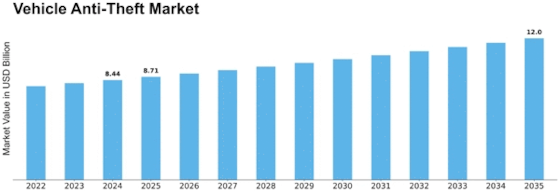


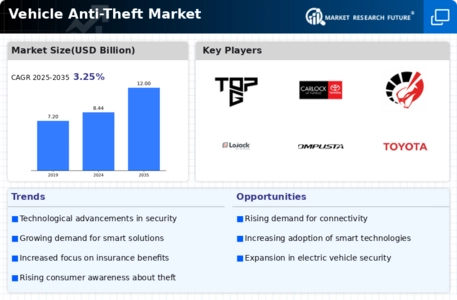



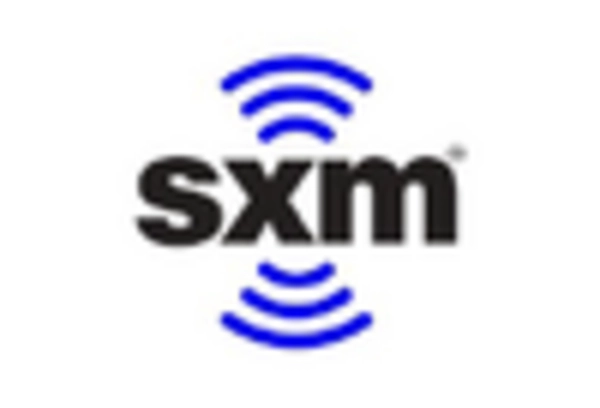
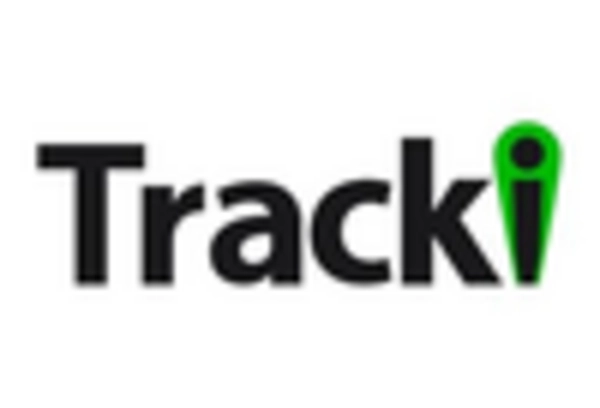
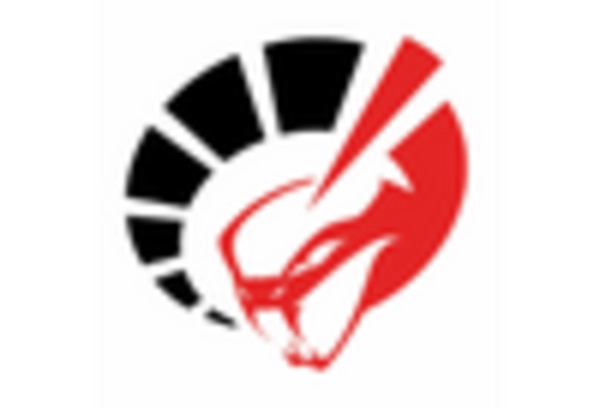









Leave a Comment